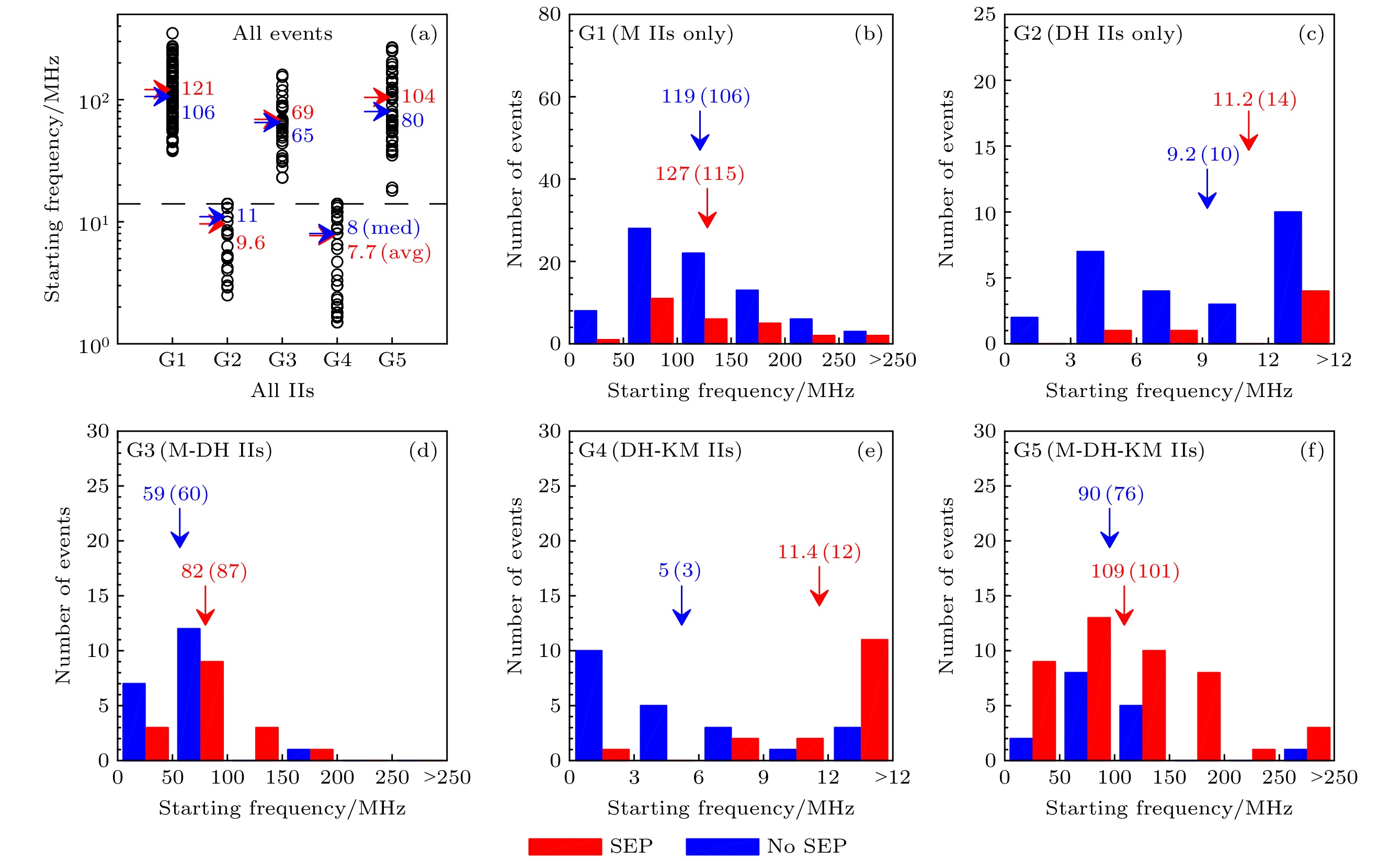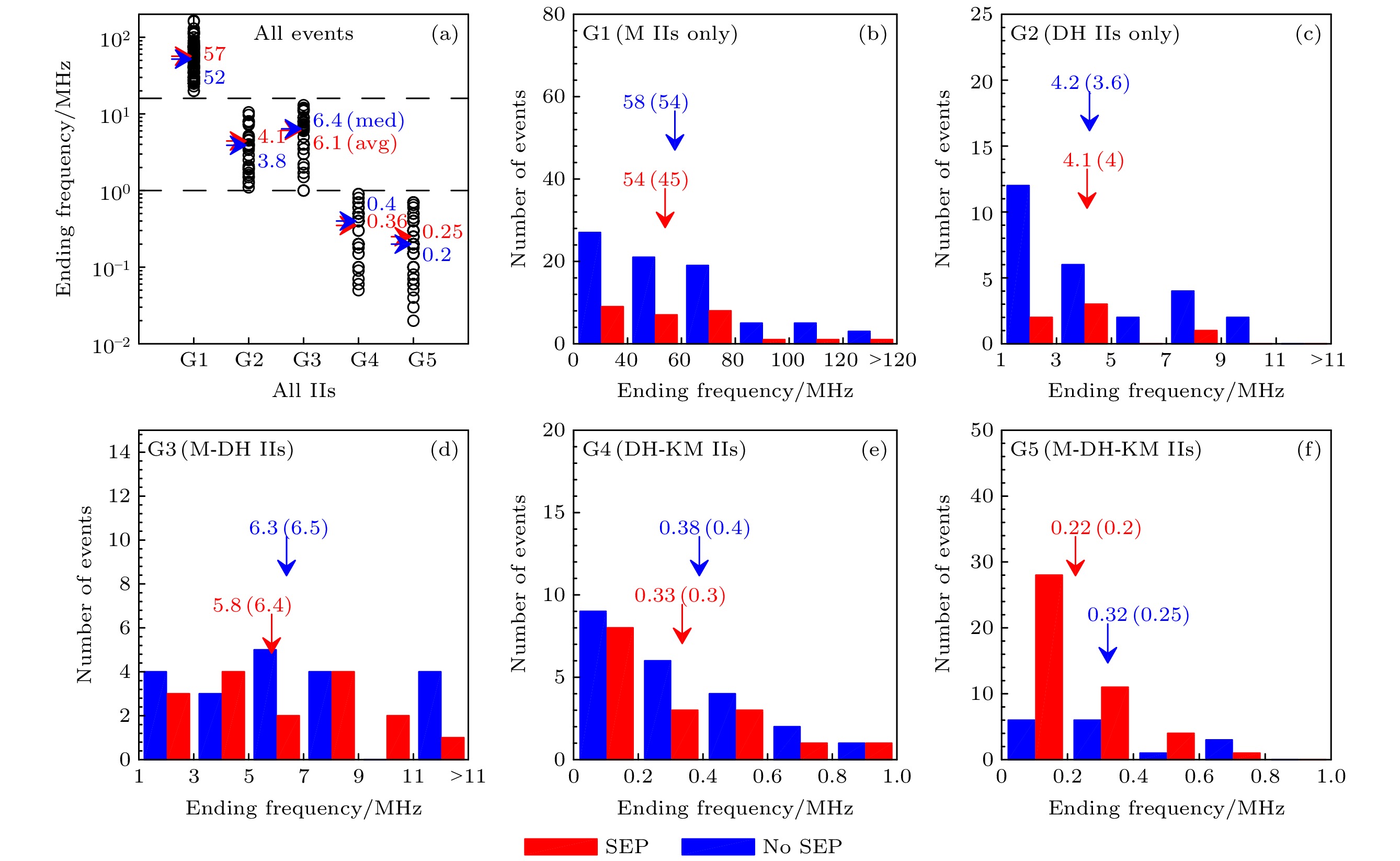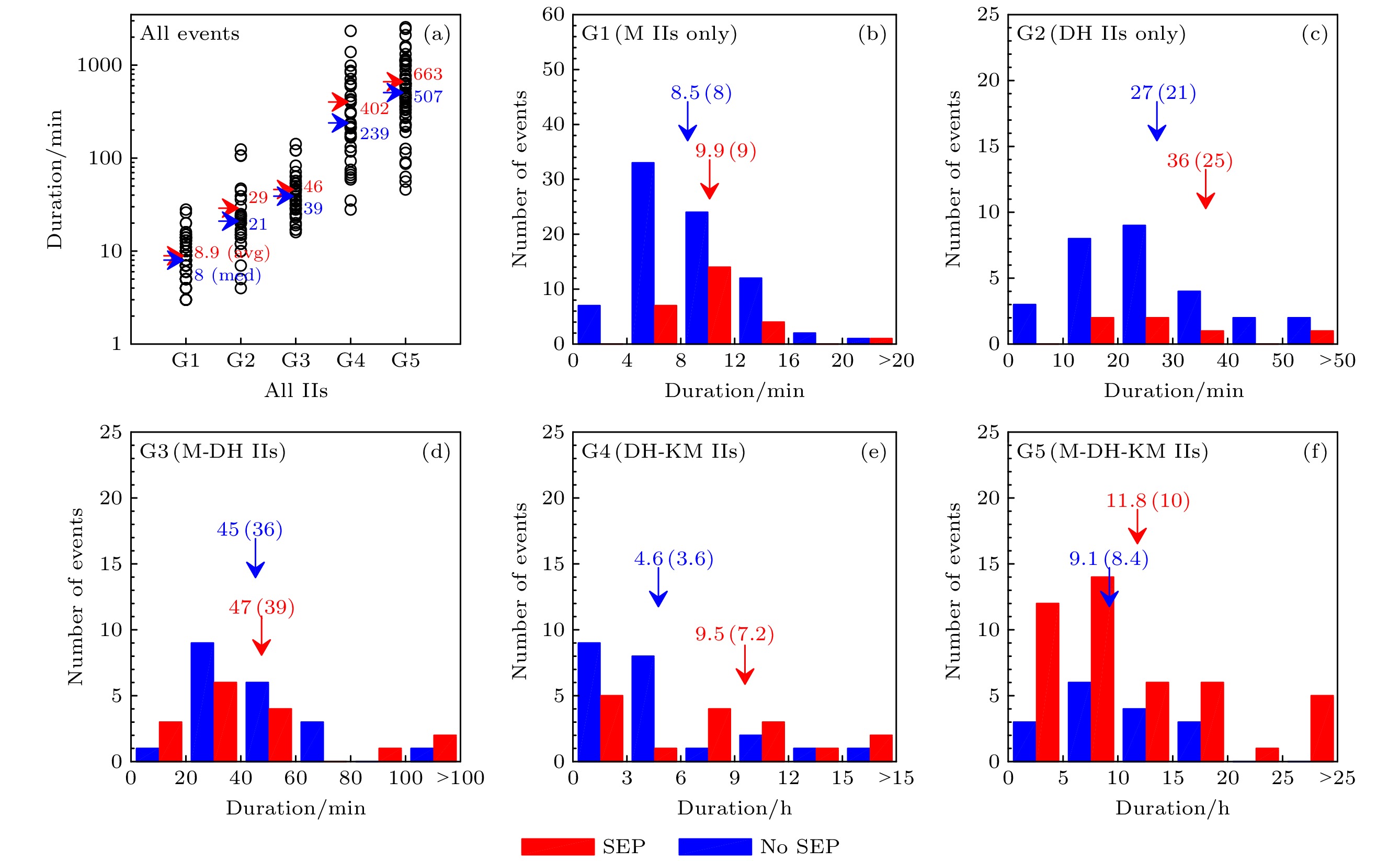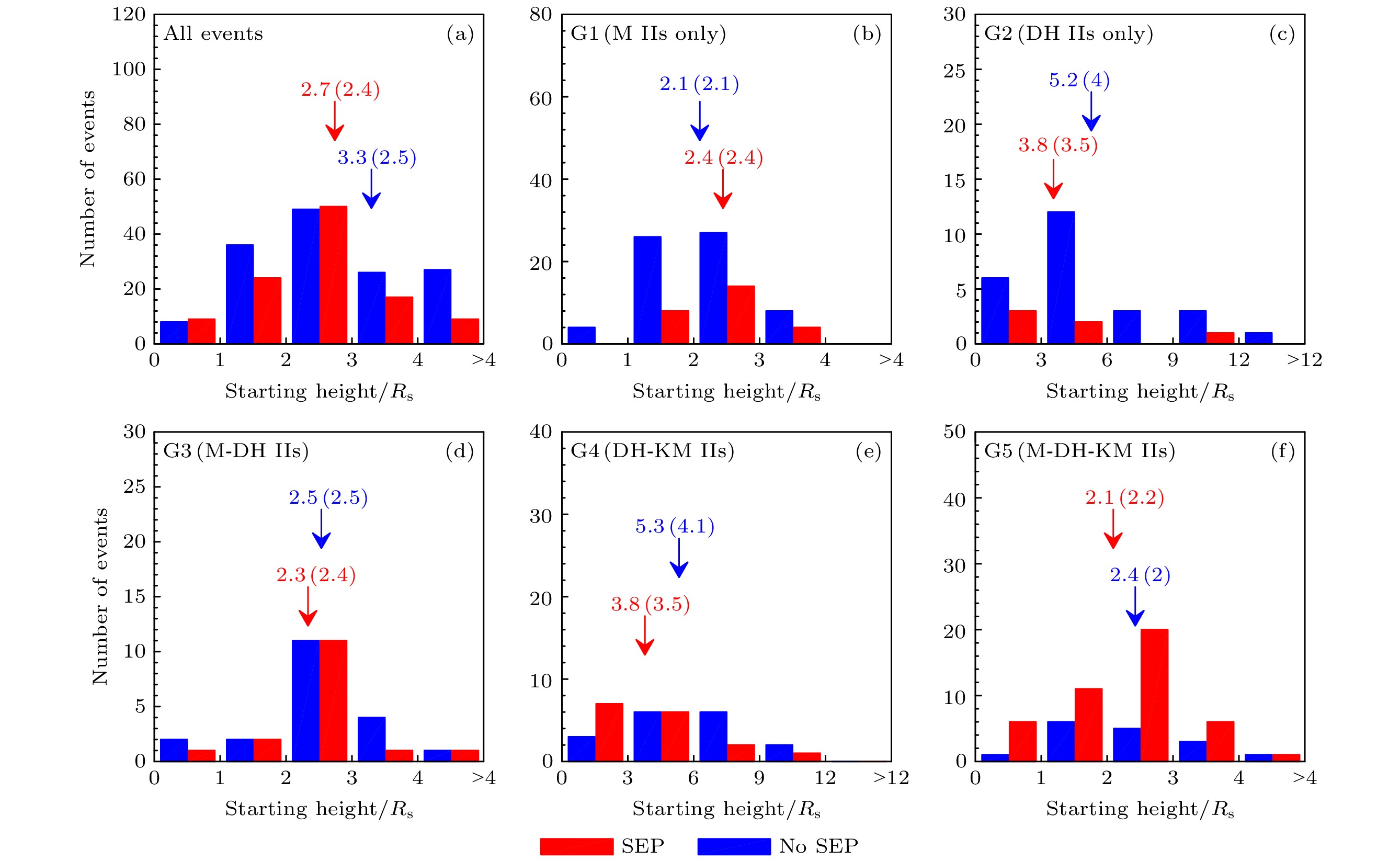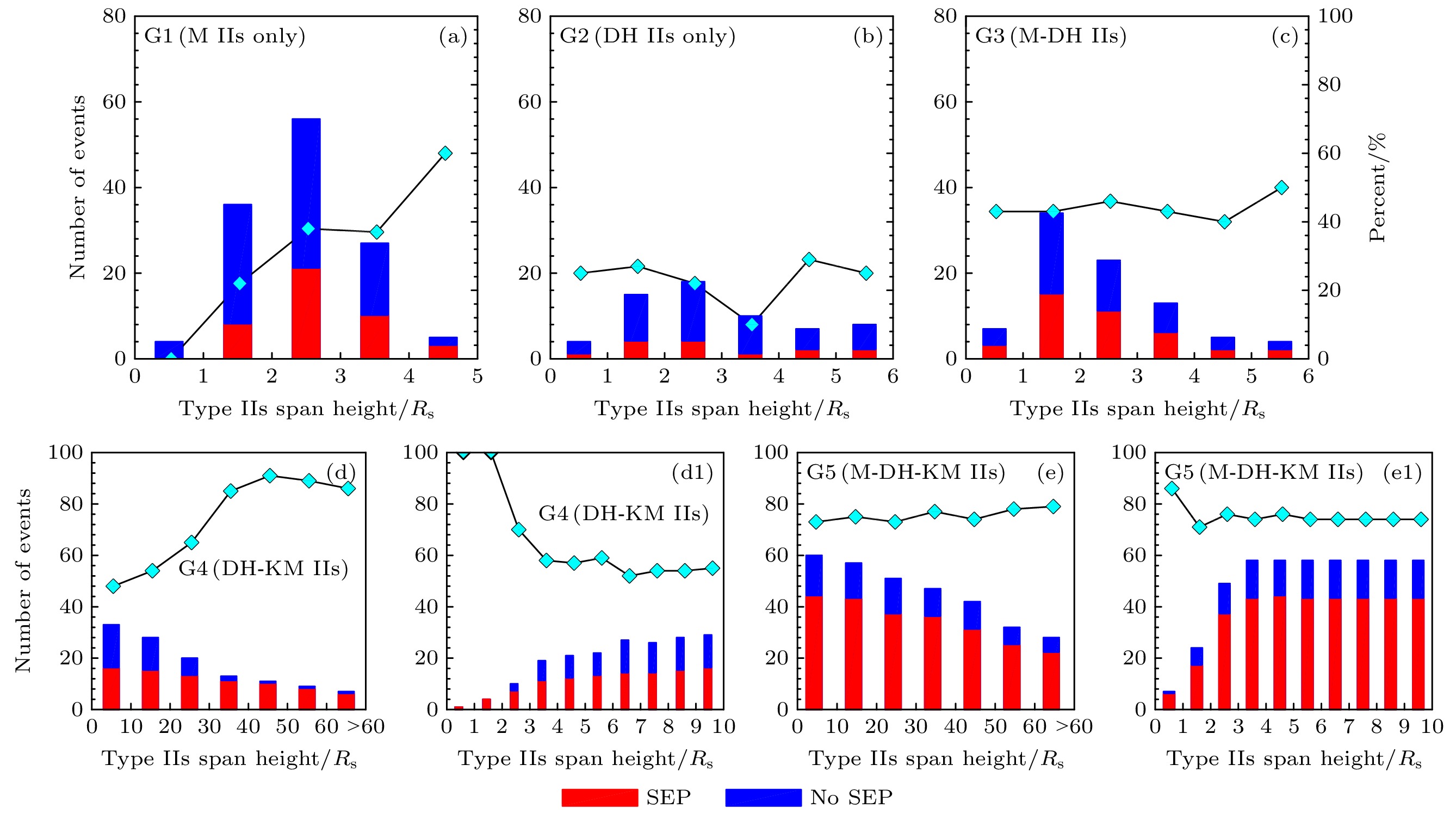-
In this paper, we investigate 273 type II radio burst events detected by Wind, STEREO spacecraft from January 2010 to March 2018 during the 24th solar cycle. We classify all events as five groups or sub-types according to their starting and ending frequencies, and then analyze the observed characteristics of each group of type II radio bursts and the correlation between the occurrence of solar energetic particle (SEP) events and the associated coronal mass ejection (CME) or type II radio bursts. What we find is as follows. 1) In each group of type II radio burst events, the CME speed (v), width (WD), mass (m), and kinetic energy (Ek) associated with SEP events are generally greater than those with no SEP events, indicating that the generation of SEP events requires a fast and wide energetic CME eruption. 2) Compared with type II radio bursts starting from the DH band, type II radio bursts starting from the metric band have a higher proportion of large SEP events. Multi-band type II radio bursts are more likely to produce SEP events than single-band events, where M-DH-KM type II bursts have the highest proportion of SEP events (73%), and the DH IIs only have the lowest one (19%). 3) In each kind of type II radio bursts, the type IIs with SEP events usually have higher starting frequencies (lower shock forming heights), lower ending frequencies (higher ending heights) and longer durations than those with no SEP events; coronal shock waves that are easy to produce SEP events (especially large SEP events) generally begin to form at a lower height (such as < 3Rs, Rs: solar radius), and are sustained to a much larger height (such as > 30Rs). 4) There exists a strong negative correlation between the duration and the ending frequency of type II radio burst (cc = –0.93). The proportion of SEP events increases with the increase of the duration of type II radio burst, and decreases with the increase of the ending frequency, which largely depends on the CME speed and other properties. The results of this paper further show that the generation of SEP events is greatly related to the sub-types and characteristics of type II radio bursts. The higher the starting frequencies and the lower the ending frequencies of type II radio bursts, such as M-DH-KM type II bursts, of which the CME drives to forming shock waves at a very low height and propagates to a very large height, the longer the duration of the shock, the longer the time it takes to accelerate the particles, and the greater the probability of SEP events (especially large SEP events) is.
[1] Mclean D J, Labrum N R 1985 Astron. Nachr. 308 182
 Google Scholar
Google Scholar
[2] Benz A O 1986 Sol. Phys. 104 99
 Google Scholar
Google Scholar
[3] Payne-Scott R, Yabsley D E, Bolton J G 1947 Nature 160 256
 Google Scholar
Google Scholar
[4] Wild J P, McCready L L 1950 Aust. J. Chem. 3 387
 Google Scholar
Google Scholar
[5] Nelson G J, Melrose D B 1985 Type II Bursts (Cambridge and New York: Cambridge University Press) pp333−359
[6] Cane H V 1983 Solar Physics (Pasadena: JPL Solar Wind Five) pp703−709
[7] Gopalswamy N, Thompson B J 2000 J. Atmos. Solar-Terr. Phys. 62 1457
 Google Scholar
Google Scholar
[8] Cane H V, Stone R G, Fainberg J, Stewart R T, Steinberg J L, Hoang S 1981 Geophys. Res. Lett. 8 1285
 Google Scholar
Google Scholar
[9] Prakash O, Umapathy S, Shanmugaraju A, Vršnak B 2009 Sol. Phys. 258 105
 Google Scholar
Google Scholar
[10] Prakash O, Umapathy S, Shanmugaraju A, Pappa Kalaivani P, Vršnak B 2010 Sol. Phys. 266 135
 Google Scholar
Google Scholar
[11] Gopalswamy N, Yashiro S, Kaiser M L, Howard R A, Bougeret J L 2001 J. Geophys. Res. Atmos. 106 29219
 Google Scholar
Google Scholar
[12] Lara A, Gopalswamy N, Nunes S, Muñoz G, Yashiro S 2003 J. Geophys. Res. 30 8016
 Google Scholar
Google Scholar
[13] Reams D V 1995 Rev. Geophys. 33 585
 Google Scholar
Google Scholar
[14] Reams D V 1999 Space. Sci. Rev. 90 413
 Google Scholar
Google Scholar
[15] Kahler S W 1996 Amer. Inst. Phys. 374 61
 Google Scholar
Google Scholar
[16] Kahler S W, Vourlidas A 2005 J. Geoghys. Res. 110 A12S01
 Google Scholar
Google Scholar
[17] Kahler S W 2001 J. Geophys. Res. 106 20947
 Google Scholar
Google Scholar
[18] Kahler S W, Vourlidas A 2014 Astrophys. J. 784 47
 Google Scholar
Google Scholar
[19] Desai M, Giacalone J 2016 Rev. Sol. Phys. 13 3
 Google Scholar
Google Scholar
[20] Lugaz N, Temmer M, Wang Y M, Farrugia C J 2017 Sol. Phys. 292 64
 Google Scholar
Google Scholar
[21] Le G M, Li C, Zhang X F 2017 Res. Astron. Astrophys. 17 073
 Google Scholar
Google Scholar
[22] Le G M, Zhang X F 2017 Res. Astron. Astrophys. 17 123
 Google Scholar
Google Scholar
[23] Zhao M X, Le G M, Chi Y T 2018 Res. Astron. Astrophys. 18 074
 Google Scholar
Google Scholar
[24] Zhao M X, Le G M 2020 Res. Astron. Astrophys. 20 037
 Google Scholar
Google Scholar
[25] Gopalswamy N, Yashiro S, Lara A, Kaiser M L, Thompson B J, Gallagher P T, Howard R A 2003 Goephys. Res. Lett. 30 12
 Google Scholar
Google Scholar
[26] Cliver E W, Kahler S W 2004 Astrophys. J. 605 902
 Google Scholar
Google Scholar
[27] Gopalswamy N, Aguilar-Rodriguez E, Yashiro S, Nunes S, Kaiser M L, Howard R A 2005 J. Geophys. Res. 110 A12S07
 Google Scholar
Google Scholar
[28] Winter L M, Ledbetter K, 2015 Astrophys. J. 809 105
 Google Scholar
Google Scholar
[29] 陈玉林, 季晶晶, 董丽花, 丁留贯, 李鹏 2015 大气科学学报 38 259
 Google Scholar
Google Scholar
Chen Y L, Ji J J, Dong L H, Ding L G, Li P 2015 Trans. Atmos. Sci. 38 259
 Google Scholar
Google Scholar
[30] Marqué C, Posner A, Klein K L 2006 Astrophys. J. 642 1222
 Google Scholar
Google Scholar
[31] Kahler S W 2005 Astrophys. J. 628 1014
 Google Scholar
Google Scholar
[32] Su W, Cheng X, Ding M D, Sun J Q 2015 Astrophys. J. 804 88
 Google Scholar
Google Scholar
[33] 王智伟, 丁留贯, 周坤论, 乐贵明 2018 地球 61 3515
 Google Scholar
Google Scholar
Wang Z W, Ding L G, Zhou K L, Le G M 2018 Chin. J. Geophys. 61 3515
 Google Scholar
Google Scholar
[34] Ding L G, Wang Z W, Feng L, Li G, Jiang Y 2019 Res. Astron. Astrophys. 19 001
 Google Scholar
Google Scholar
[35] Tylka A J, Cohen C M S, Dietrich W F, Krucker S, McGuire R E, Mewaldt R A, Ng C K, Reames D V, Share G H 2003 Proceeding of the 28th International Cosmic Ray Conference Tsukuba, Japan, July 31−August 7, 2003 p3305
[36] Kim R S, Cho K S, Lee J, Bong S C, Park Y D 2014 J. Geophys. Res. A: Space Phys. 119 9419
 Google Scholar
Google Scholar
[37] Ding L G, Cao X X, Wang Z W, Le G M 2016 Res. Astron. Astrophys. 16 8
 Google Scholar
Google Scholar
[38] Bemporad A, Manceso S 2013 J. Adv. Res. 4 287
 Google Scholar
Google Scholar
[39] 周坤论, 丁留贯, 王智伟, 封莉 2019 68 139601
 Google Scholar
Google Scholar
Zhou K L, Ding L G, Wang Z W, Feng L 2019 Acta Phys. Sin. 68 139601
 Google Scholar
Google Scholar
[40] Shanmugaraju A, Moon Y J, Dryer M, Umapathy S 2003 Sol. Phys. 217 301
 Google Scholar
Google Scholar
[41] 周坤论, 丁留贯, 钱天麒, 朱聪, 王智伟, 封莉 2020 69 169601
 Google Scholar
Google Scholar
Zhou K L, Ding L G, Qian T Q, Zhu C, Wang Z W, Feng L 2020 Acta Phys. Sin. 69 169601
 Google Scholar
Google Scholar
-
表 1 II型射电暴伴随SEP事件的统计表
Table 1. SEP events associated with different group of type II radio bursts.
事件类型 G1 G2 G3 G4 G5 All IIs事件数 107 32 36 38 60 273 无SEP事件数 80 26 20 22 16 164 SEP事件数 27 6 16 16 44 109 SEP事件占比/% 25 19 44 42 73 40 大SEP事件数 13 3 12 13 40 81 大SEP事件占比/% 12 9 33 34 67 30 SEP事件强度均值 0.53 0.02 0.49 4.89 38.74 16.41 SEP事件强度中值 0.01 0.01 0.2 0.24 0.53 0.09 大SEP事件强度均值 1.09 0.04 0.65 6.02 42.62 22.28 大SEP事件强度中值 0.13 0.02 0.33 0.25 0.6 0.34 表 2 耀斑特征时间统计表
Table 2. Characteristic times of associated solar flares.
类型 T 1/min T 2/min 均值 中值 均值 中值 G1: M IIs only 14 10 26 19 G2: DH IIs only 38 18 66 33 G3: M-DH IIs 19 16 32 27 G4: DH-KM IIs 35 23 70 52 G5: M-DH-KM IIs 46 22 73 49 -
[1] Mclean D J, Labrum N R 1985 Astron. Nachr. 308 182
 Google Scholar
Google Scholar
[2] Benz A O 1986 Sol. Phys. 104 99
 Google Scholar
Google Scholar
[3] Payne-Scott R, Yabsley D E, Bolton J G 1947 Nature 160 256
 Google Scholar
Google Scholar
[4] Wild J P, McCready L L 1950 Aust. J. Chem. 3 387
 Google Scholar
Google Scholar
[5] Nelson G J, Melrose D B 1985 Type II Bursts (Cambridge and New York: Cambridge University Press) pp333−359
[6] Cane H V 1983 Solar Physics (Pasadena: JPL Solar Wind Five) pp703−709
[7] Gopalswamy N, Thompson B J 2000 J. Atmos. Solar-Terr. Phys. 62 1457
 Google Scholar
Google Scholar
[8] Cane H V, Stone R G, Fainberg J, Stewart R T, Steinberg J L, Hoang S 1981 Geophys. Res. Lett. 8 1285
 Google Scholar
Google Scholar
[9] Prakash O, Umapathy S, Shanmugaraju A, Vršnak B 2009 Sol. Phys. 258 105
 Google Scholar
Google Scholar
[10] Prakash O, Umapathy S, Shanmugaraju A, Pappa Kalaivani P, Vršnak B 2010 Sol. Phys. 266 135
 Google Scholar
Google Scholar
[11] Gopalswamy N, Yashiro S, Kaiser M L, Howard R A, Bougeret J L 2001 J. Geophys. Res. Atmos. 106 29219
 Google Scholar
Google Scholar
[12] Lara A, Gopalswamy N, Nunes S, Muñoz G, Yashiro S 2003 J. Geophys. Res. 30 8016
 Google Scholar
Google Scholar
[13] Reams D V 1995 Rev. Geophys. 33 585
 Google Scholar
Google Scholar
[14] Reams D V 1999 Space. Sci. Rev. 90 413
 Google Scholar
Google Scholar
[15] Kahler S W 1996 Amer. Inst. Phys. 374 61
 Google Scholar
Google Scholar
[16] Kahler S W, Vourlidas A 2005 J. Geoghys. Res. 110 A12S01
 Google Scholar
Google Scholar
[17] Kahler S W 2001 J. Geophys. Res. 106 20947
 Google Scholar
Google Scholar
[18] Kahler S W, Vourlidas A 2014 Astrophys. J. 784 47
 Google Scholar
Google Scholar
[19] Desai M, Giacalone J 2016 Rev. Sol. Phys. 13 3
 Google Scholar
Google Scholar
[20] Lugaz N, Temmer M, Wang Y M, Farrugia C J 2017 Sol. Phys. 292 64
 Google Scholar
Google Scholar
[21] Le G M, Li C, Zhang X F 2017 Res. Astron. Astrophys. 17 073
 Google Scholar
Google Scholar
[22] Le G M, Zhang X F 2017 Res. Astron. Astrophys. 17 123
 Google Scholar
Google Scholar
[23] Zhao M X, Le G M, Chi Y T 2018 Res. Astron. Astrophys. 18 074
 Google Scholar
Google Scholar
[24] Zhao M X, Le G M 2020 Res. Astron. Astrophys. 20 037
 Google Scholar
Google Scholar
[25] Gopalswamy N, Yashiro S, Lara A, Kaiser M L, Thompson B J, Gallagher P T, Howard R A 2003 Goephys. Res. Lett. 30 12
 Google Scholar
Google Scholar
[26] Cliver E W, Kahler S W 2004 Astrophys. J. 605 902
 Google Scholar
Google Scholar
[27] Gopalswamy N, Aguilar-Rodriguez E, Yashiro S, Nunes S, Kaiser M L, Howard R A 2005 J. Geophys. Res. 110 A12S07
 Google Scholar
Google Scholar
[28] Winter L M, Ledbetter K, 2015 Astrophys. J. 809 105
 Google Scholar
Google Scholar
[29] 陈玉林, 季晶晶, 董丽花, 丁留贯, 李鹏 2015 大气科学学报 38 259
 Google Scholar
Google Scholar
Chen Y L, Ji J J, Dong L H, Ding L G, Li P 2015 Trans. Atmos. Sci. 38 259
 Google Scholar
Google Scholar
[30] Marqué C, Posner A, Klein K L 2006 Astrophys. J. 642 1222
 Google Scholar
Google Scholar
[31] Kahler S W 2005 Astrophys. J. 628 1014
 Google Scholar
Google Scholar
[32] Su W, Cheng X, Ding M D, Sun J Q 2015 Astrophys. J. 804 88
 Google Scholar
Google Scholar
[33] 王智伟, 丁留贯, 周坤论, 乐贵明 2018 地球 61 3515
 Google Scholar
Google Scholar
Wang Z W, Ding L G, Zhou K L, Le G M 2018 Chin. J. Geophys. 61 3515
 Google Scholar
Google Scholar
[34] Ding L G, Wang Z W, Feng L, Li G, Jiang Y 2019 Res. Astron. Astrophys. 19 001
 Google Scholar
Google Scholar
[35] Tylka A J, Cohen C M S, Dietrich W F, Krucker S, McGuire R E, Mewaldt R A, Ng C K, Reames D V, Share G H 2003 Proceeding of the 28th International Cosmic Ray Conference Tsukuba, Japan, July 31−August 7, 2003 p3305
[36] Kim R S, Cho K S, Lee J, Bong S C, Park Y D 2014 J. Geophys. Res. A: Space Phys. 119 9419
 Google Scholar
Google Scholar
[37] Ding L G, Cao X X, Wang Z W, Le G M 2016 Res. Astron. Astrophys. 16 8
 Google Scholar
Google Scholar
[38] Bemporad A, Manceso S 2013 J. Adv. Res. 4 287
 Google Scholar
Google Scholar
[39] 周坤论, 丁留贯, 王智伟, 封莉 2019 68 139601
 Google Scholar
Google Scholar
Zhou K L, Ding L G, Wang Z W, Feng L 2019 Acta Phys. Sin. 68 139601
 Google Scholar
Google Scholar
[40] Shanmugaraju A, Moon Y J, Dryer M, Umapathy S 2003 Sol. Phys. 217 301
 Google Scholar
Google Scholar
[41] 周坤论, 丁留贯, 钱天麒, 朱聪, 王智伟, 封莉 2020 69 169601
 Google Scholar
Google Scholar
Zhou K L, Ding L G, Qian T Q, Zhu C, Wang Z W, Feng L 2020 Acta Phys. Sin. 69 169601
 Google Scholar
Google Scholar
Catalog
Metrics
- Abstract views: 6489
- PDF Downloads: 79
- Cited By: 0














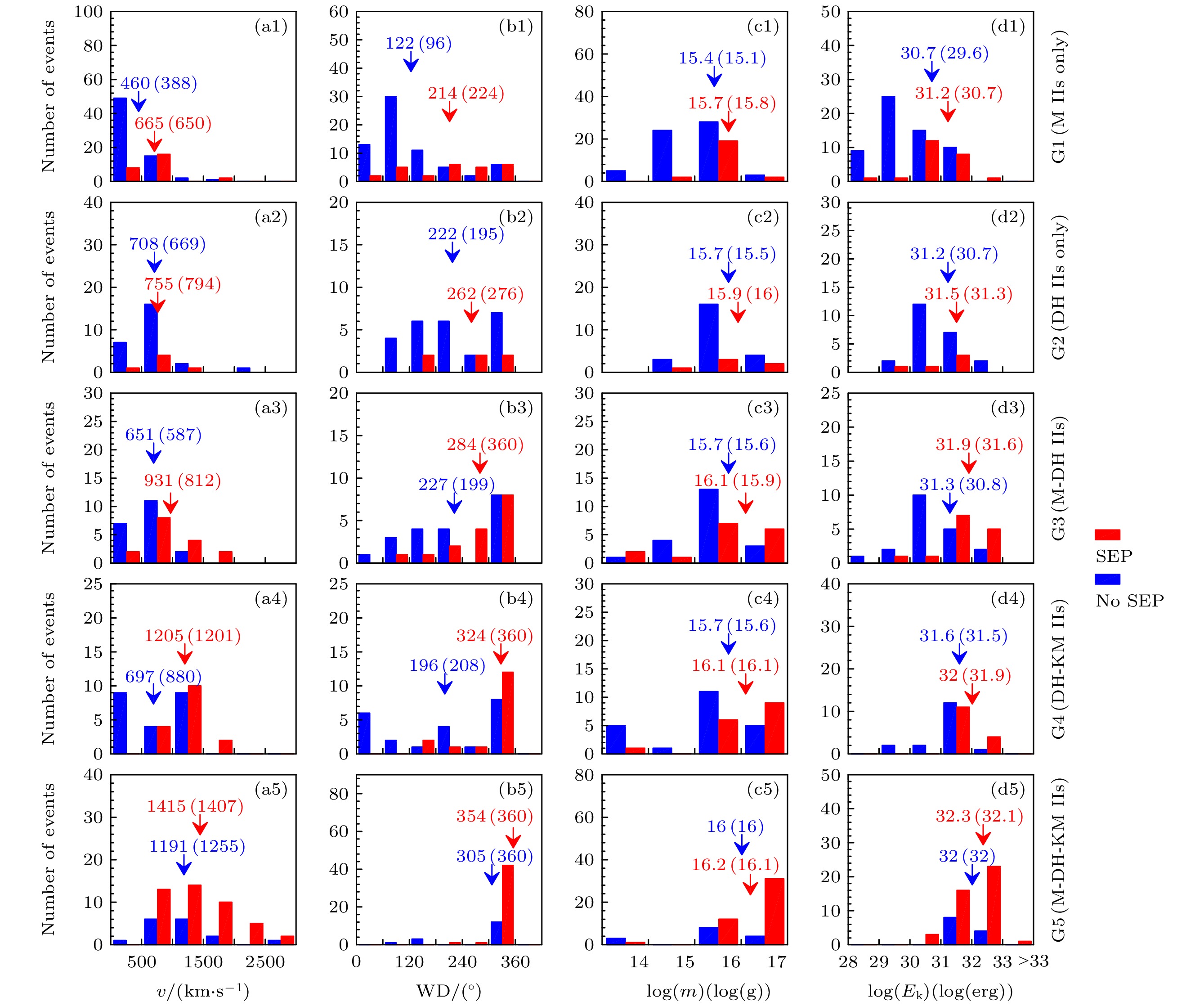
 DownLoad:
DownLoad:

